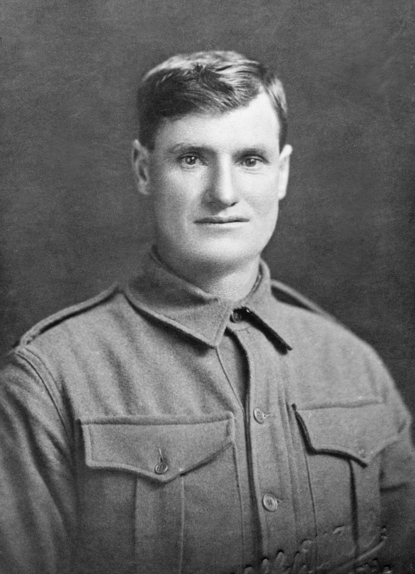

Charles Albert STOKES
Born 29 June 1885 in Ballarat, Victoria, Australia [30]
Son of George William STOKES and Mary BROWN [54]
Married Ellen Annie BAGLEY in Perth in 1907 [66]
In 1916 was working as a Horse Driver and was living at 193 York Street in the Perth suburb of Subiaco [18]
Enlisted in the Australian Imperial Force (A.I.F.) in Perth on 5 March 1916 [30: item 8089863]
Upon enlistment he was 5 feet 10 inches tall, weighed 155 pounds and had grey eyes, dark hair and a fresh complexion [30]
After training in Claremont he was appointed on 5 August 1916 to the 4th Reinforcements of the 51st Infantry Battalion [30]
Embarked from Fremantle, Western Australia for active service abroad on the H.M.A.T. A28 Miltiades on 9 August 1916 [30]
Disembarked in England and after more training proceeded to France on the steamship Princess Victoria on 4 December 1916 [30]
Private 2253 in the Australian Imperial Force's 51st Infantry Battalion in France during the First World War [30]
Served under the rank of Private until being appointed Lance Corporal in France on 20 April 1917 [30]
Wounded in Action in France on 26 September 1917 and was evacuated to England with a gunshot wound to his right shoulder [30]
After just under two months hospitalisation and recovery in England he once again proceeded to France 23 November 1917 [30]
Promoted to Temporary Corporal on 1 January 1918, to Corporal on 12 April 1918 and to Sergeant on 21 April 1918 [30]
Embarked from England on the H.T. Kildonian Castle and disembarked in Fremantle, Western Australia on 5 May 1919 [30]
Discharged from the A.I.F. on 12 June 1919; received the British War Medal, Victory Medal and Distinguished Conduct Medal [30]
He was welcomed home by the people of Wannamal at a Tea, Social & Dance in Wannamal on Saturday 31 May 1919 [9: 13-Jun-1918]
Also a guest of honour at the "Welcome Home" at the Wannamal Hall in Wannamal on the evening of 20 September 1919 [9: 3-Oct-1919]
Over 200 people attended the function which tendered a welcome home to himself, John L. BAGLEY and Walter V. BAGLEY [9]
Resided at 38 Denis Street in the Perth suburb of Subiaco from as early as 1928 until at least 1961 [6] [30: item 8089863]
Wheat Carting Contractor who visited Carnamah annually during the wheat carting season 1928-1936 [P399]
He is said to have done his wheat carting in Carnamah with a V8 truck with a four-wheel trailer [P399]
Worked in Carnamah during the 1933 harvest and was accompanied by his wife and children [5: 24-Nov-1933, 19-Jan-1934]
Began advertising his services as a wheat carter in The North Midland Times newspaper on Friday 20 July 1934 [5: 20-Jul-1934]
The advertisement notified old and intending clients he would be returning to Carnamah well equipped for the 1934 harvest [5]
After finishing wheat carting left Carnamah on Thursday 10 January 1935 and returned to his home in Subiaco [5: 11-Jan-1935]
From 11 October 1935 he and his brother-in-law Walter V. BAGLEY advertised in The North Midland Times [5: 11-Oct-1935]
Advertised to notify old and new clients that they would be returning to Carnamah equipped for the coming wheat carting season [5]
He and his wife arrived in Carnamah on Wednesday 4 November 1936 [5: 6-Nov-1936]
After wheat carting in Carnamah he returned to Subiaco on Saturday 19 December 1936 [5: 24-Dec-1936]
On his return to Subiaco he was accompanied by his daughter Mrs Veronica E. MCGOWAN and young grandson of Carnamah [5]
Resided in the Perth suburb of Subiaco until his death in 1969 [2]
Died 19 November 1969; buried at the Karrakatta Cemetery in Perth, Western Australia (Roman Catholic, Lawn 2, S004) [2]
From The Commonwealth of Australia Gazette, No. 15, 4 February 1919:
Charles Albert Stokes. Distinguished Conduct Medal.
"For conspicuous gallantry and devotion to duty. Sergeant Stokes led a section of bombers, against some machine gun positions, which were holding up the advance of the flank of his company. All the section except himself became casualties; but two of the guns were put out of action, and their detachment killed, and then Sergeant Stokes attacked the remaining gun single handed, and captured it killing or wounding all the crew. During all this time he was under machine gun fire of great severity. On returning to his platoon, he found his commander had become a casualty and he at once took command, and led the men forward. His very gallant behaviour and coolness under fire of the heaviest description were an example worthy of the highest praise."
| Reference: Carnamah Historical Society & Museum and North Midlands Project, 'Charles Albert Stokes' in Biographical Dictionary of Coorow, Carnamah and Three Springs, retrieved 16 December 2025 from www.carnamah.com.au/bio/charles-albert-stokes [reference list] |
 |
Use the below form or email history@carnamah.com.au |




